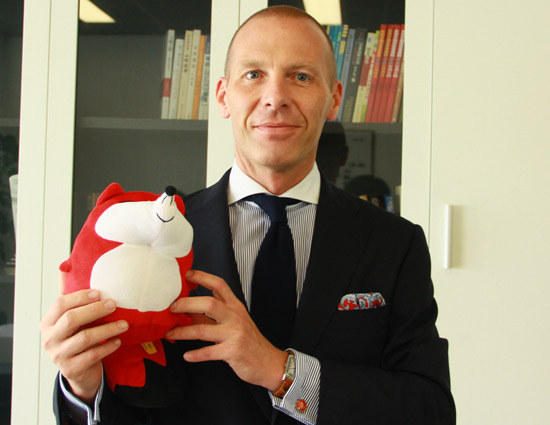 人参与)
人参与)作者:崔娜 翻译:Casey
How can Boesch, whose leadership style differs drastically from that of his two predecessors, lead Audi in its shift from the most valued to the most progressive? In the post- 2 millionth era, how can he manage to keep Audi’s market dominance?
【点击查看中文文章】
【进入专题】
 |
| Dominique Boesch, President of Audi Sales Division, FAW-Volkswagen Automotive Co., Ltd. |
Leader’s Path
In 1988, with a black Audi100 entering the Chinese people’s sight as it cantered along from Changchun, Audi began its China chapter. Now 25 years later, its four ring image is seen everywhere on Chinese streets, a fitting testament to Audi’s success in China.
A closer look at Audi’s performance in China in the past 25 years reveals some impressive numbers: sales volume reached 400,000 in 2010, a year-on-year increase of 30%, and it hit 228,000 in the first half of 2013; 309 dealerships scatter in 143 cities throughout the country; and the deal to sell the 200 millionth unit has just been closed and the car delivered; a total of 31 models are currently on sale; 4 locally manufactured models have come into being, with 2 world-class production bases in southern China and northern China……These are the makings of the champion of China’s luxury car market.
But Rome wasn’t built in a day. 22 years have elapsed since FAW signed the license agreement on technology transfer to produce Audi vehicles and since Audi 100 was assembled and manufactured. Now FAW-Volkswagen Audi has ascended the throne as the king of China’s luxury car market, which was surely the company’s defining moment, also the most exhilarating to the Audi people.
In 2008, Johannes Thammer, who just assumed the position of President of Audi Sales Division, said half-jokingly in an interview, “I’ll only go back to Germany when the Chinese market overtakes the German one”. This vision was realized in the first half of 2010, when Audi’s sales in China reached 108,600 units.
This success offered the best opportunity for Thammer to return to Germany. Taking over the helm was Boesch, then President of Audi in Japan.
Greeting Boesch in Audi’s newly conquered and also its largest market in the world, were countless pairs of scrutinizing eyes, not the warm hospitality the ancient oriental country is famed for. In Boesch’s first year in his new position, he was repeatedly criticized by the outside for his conservative strategy. Many people doubted that someone who used to manage a small market with a yearly sales volume of less than 10,000 had the capability of managing a big market with a sales volume above 200,000 a year. Some even went so far as to predicting Boesch to be the most mediocre among the 3 non-Chinese leaders in the Audi Sales Division, and that he might witness Audi being surpassed by other carmakers in the Chinese market, the largest in the world.
As everyone can see, the reality is just the opposite of the prediction. Under Boesch’s leadership, Audi forged ahead, not being beaten by rivals but closing the gap between himself and its rivals.
With the combined forces of Audi A4L, Q5 and Q3, the 4 locally manufactured models, sales in 2012 exceeded 400,000 units for the first time. This year’s sales target of “another 100 million units within 3 years” will be achieved ahead of schedule.
On July 19, 2013, in Sohu Auto’s exclusive interview, Boesch spoke highly of the company’s achievements in the past 25 years and the new changes that have taken place since he assumed the current position. He was convinced that Audi would maintain its leadership. “Judging by Audi’s overall strength, I believe it is stronger than its competitors in the Chinese market,” he said.
And speaking of Audi’s success over the years, Boesch attributed it to “whole value chain localization and high-quality growth”.
Audi was the first high-end luxury vehicle brand to have entered the Chinese market. Since the company’s early days in China, shareholders of both FAW and Audi have chosen localization as its core development mode. To this end, the company has made a series of localization moves in R&D, production, purchasing and marketing. Up to now, its average localization rate has reached 60% and is expected to reach 80% in the future.
The so-called “high-quality growth”, according to Boesch, is accomplished by extending product lines and expanding the dealership network, increasing client satisfaction and adopting new technology.
The above approach has enabled Audi to maintain its good shape in China. But with the slow growth in the Chinese market, when rivals start to shift their focus onto localization, the sales gap between them and Audi are beginning to narrow.
According to Boesch, his responsibility in his term is to consolidate the company’s leadership position in the Chinese market. Can his dream come true? A company needs different styles of leadership at different development stages. Is Boesch, whose leadership style differs drastically from that of his two predecessors, really the person Audi needs at its current stage? And what is the basis for his conviction that Audi will keep its superior stature in the Chinese luxury car market?
| [1] [2] [3] [4] [5] [6] [7] [8] [下一页] |
|
|
E电园纯电皮卡是啥妖孽
E电园试北汽纯电EU260